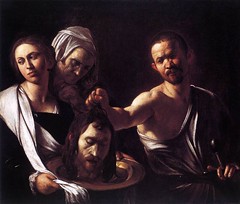Michelangelo Merisi da Caravaggio (29 September 1571 – 18 July 1610) was an Italian artist active in Rome, Naples, Malta, and Sicily between 1593 and 1610, says Wikipedia.
His paintings, which combine a realistic observation of the human state, both physical and emotional, with a dramatic use of lighting, had a formative influence on the Baroque school of painting. Among others, he influenced Rembrandt.
Caravaggio's style was a radical naturalism which combined close physical observation with a dramatic, even theatrical, use of chiaroscuro. He painted the shift from light to dark with little intermediate value.
He burst upon the Rome art scene in 1600 with the success of his first public commissions, the Martyrdom of Saint Matthew and Calling of Saint Matthew. Thereafter he never lacked for commissions or patrons, yet he handled his success badly, being caught in several felonious assaults.
The Cardsharps is perhaps Caravaggio's first true masterpiece.
Already evident was the intense realism or naturalism for which Caravaggio is now famous. He preferred to paint his subjects as the eye sees them, with all their natural flaws and defects instead of as idealised creations. This allowed a full display of Caravaggio's virtuosic talents. This shift from accepted standard practice and the classical idealism of Michelangelo was very controversial at the time. Not only was his realism a noteworthy feature of his paintings during this period, he turned away from the lengthy preparations traditional in central Italy at the time. Instead, he preferred the Venetian practice of working in oils directly from the subject - half-length figures and still life.
In 1599, presumably through the influence of Cardinal Del Monte, Caravaggio was contracted to decorate the Contarelli Chapel. The two works making up the commission, the Martyrdom of Saint Matthew and Calling of Saint Matthew, delivered in 1600, were an immediate sensation.
Major works from his Malta (Mediterranean island south of Sicily) period include a huge Beheading of Saint John the Baptist (the only painting to which he put his signature) and a Portrait of Alof de Wignacourt and his Page, as well as portraits of other leading knights.
He painted also a David with the Head of Goliath, showing the young David with a strangely sorrowful expression gazing on the severed head of the giant, which is Caravaggio's.
Tuesday, March 22, 2011
Subscribe to:
Post Comments (Atom)





No comments:
Post a Comment